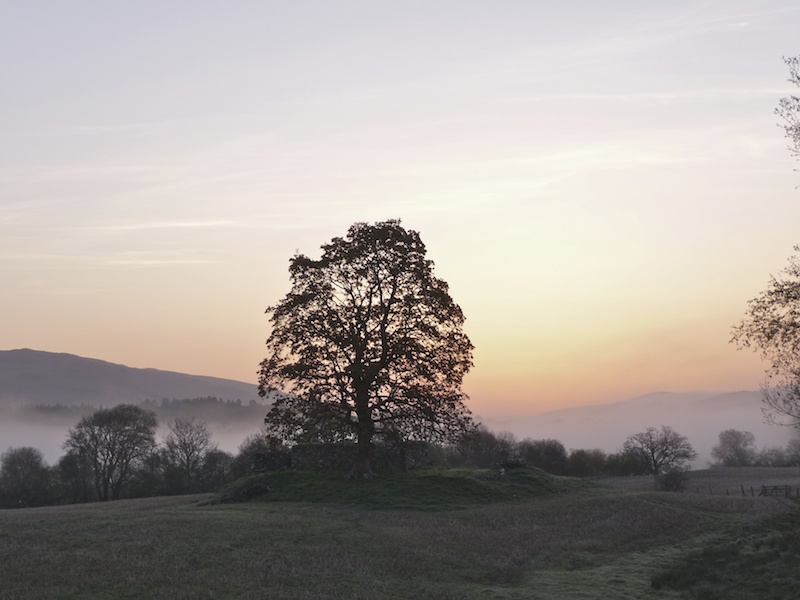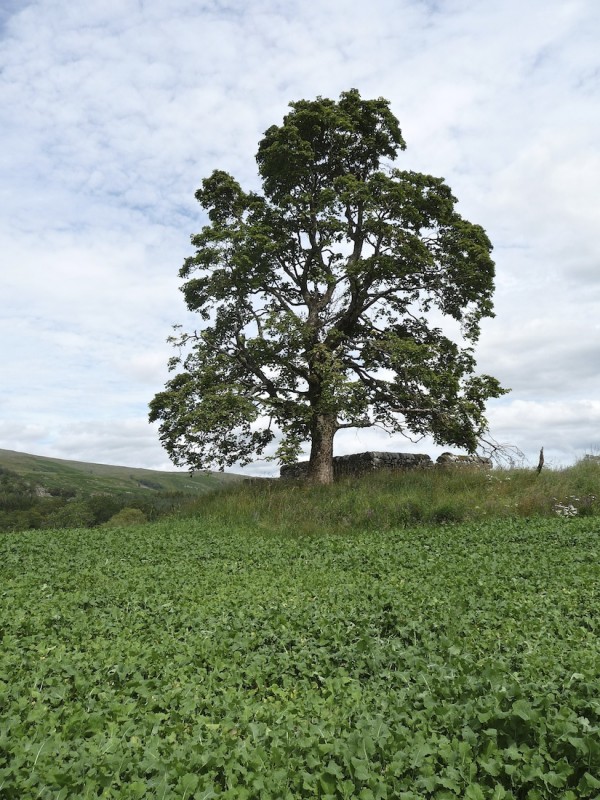
St Fillan and Glen Dochart
 An old stone wall in the middle of a field draws my attention every time we drive through Glen Dochart. Guarded by a big sycamore tree, this simple rectangular enclosure is a graveyard belonging to the MacNab clan.
An old stone wall in the middle of a field draws my attention every time we drive through Glen Dochart. Guarded by a big sycamore tree, this simple rectangular enclosure is a graveyard belonging to the MacNab clan.
One source says:
“(Luib in Glen Dochart): There is an ancient McNab burial ground on the south side of the road on a little grassy knoll with trees. There are several gravestones here, some of them legible, some less so, and all appear to be to members of the McNab family.”
What interested me even more was the mention of a cross-incised slab at the south-east corner of the enclosure, which several experts have dated to the 6th or 7th century. This stone is described as an ‘early marker’, as opposed to a memorial or grave stone, with links to the very earliest Christian worship.
According to Canmore, the database of the RCAHMS, the cross-marked stone may be “coeval with St Fillan”; it adds: “Suie in Glen Dochart is locally connected with St Fillan, though his name is not attached to it.”
We visited the MacNab burial site on a bright August day, and I was fascinated to find the cross-marked stone at an outside corner of the walled enclosure. It stands at a slight angle, about three feet in height, with a weathered but still distinct cross carved on two of its faces. I can see why it has been called a marker stone rather than a grave slab – it is finger-like, slim and angular. In fact, it looks more like a small version of a standing stone.
Inside the enclosure are grave slabs and memorial stones dating from the 1700s and dedicated to members of the MacNab clan. Two of them show a severed chieftain’s head, which is part of the MacNab crest. The head is that of the Chief of Clan MacNeish, who was killed in a daring attack by the MacNabs in the early 1600s, in retaliation for repeated raids on their land.
One gravestone bears the MacNab motto ‘Dread Nought’, and another the words ‘Timor Omnis Abesto’ (‘Let fear be far from all’). This one also shows three crescent moons arranged above a star and what appears to be a set-square – possibly a masonic symbol.
 Built into a wall of the enclosure is a stone with the inscription:
Built into a wall of the enclosure is a stone with the inscription:
“Built by Iohn Macnab, posesser of Inishoane 1759”
I assume that the ‘Inishoane’ refers to Innisewen, a farm just across the river on the other side of the glen. Just outside, beneath the tree, some old iron railings enclose another grave from the same era.
Who was St Fillan?
Veiled by the mists of time, the story of St Fillan is fascinating…
One of the earliest missionaries who travelled from Ireland to western Scotland in the 6th Century, St Fillan’s aim was to establish a Christian monastery and spread the Gospel. He may have arrived around the same time as St Columba, who founded the abbey on Iona.
Legend has endowed St Fillan with a number of superhuman powers, and he is reputed to have killed a terrifying wild boar with “horns the size of plough shares”.
Apparently St Fillan would preach under an ash tree near the river at Killin, and he used healing stones to cure people of their illnesses. These stones, together with several other holy relics, still remain; the Clan Macnab website tells us that by tradition, the layer of river wrack, straw and twigs on which the stones are bedded is changed every Christmas Eve.
St Fillan may have been faintly amused at the way in which his ‘holy relics’ were transported reverently around the country after his death. His silver-gilt quigrich (the head of a pastoral staff) made an appearance at the Battle of Bannockburn in 1314 before being taken to Canada some 500 years later. It is now in the National Museum of Scotland in Edinburgh.
What a charming story… and a truly timeless place.
Sources:
- RCAHMS (Royal Commission on the Ancient and Historical Monuments of Scotland)
- Clan MacNab
- Am Baile
Images copyright © Colin & Jo Woolf
 Further reading
Further reading
Take a look at another McNab burial ground – this one is on a lovely little island in the River Dochart at Killin.













15 Comments
tearoomdelights
How fascinating, I must go and have a look at his quigrich (new word to me!) in Edinburgh some time, and this beautiful graveyard. He seems to have been a most interesting chap, St Fillan, and he fairly got about the country, with spending time on both the west and east coasts. I’m even more curious to visit that cave at Pittenweem now…
Jo Woolf
He does have an interesting story, and Strath Fillan is a beautiful and very tranquil place – it has a very restful atmosphere.
Maggie - an expat McNab
What a delight to come across this page and your website, by pure accident. Your words and Colin’s photographs are just magic! I can’t believe that I worked in the Tyndrum area for nearly 3 years in the late 1970’s, and never knew this graveyard existed. That was before I had any understanding of my McNab heritage. Only now as an “ageing” expatriate do I truly appreciate my own McNab (Scots/Irish) branch story. I always felt the Glen Dochart area had an amazing sense of history, a certain mystical “feel” about it – now I know why. Thank you again!!
Maggie
Jo Woolf
Thank you so much, Maggie! I’m really glad you found it, too! 🙂 I guess these old places just draw me like a magnet, because they really don’t stand out at all as you’re driving past. But there’s always something extraordinary about them. You’re so right about Glen Dochart, it has a definite mystical feel, as if time hasn’t moved on there at all. Good luck researching your heritage! 🙂
BJF
Hi Jo,
Long time no visit. I miss the tree. I could use a little peace right now. 😉 Anyway, I am reading a historical fiction novel called ‘The Spider and the Stone’ and a Glen Dochart Abbey is mentioned in the story. I decided to look up more information on it through Google and lo and behold this article is #1!! So no Abbey existed, except in the mind of the author. Appreciate your information and photos as always.
~ CW
Jo Woolf
That’s interesting! No, I couldn’t find any record of an abbey in Glen Dochart, but there are the remains of a ‘St Fillan’s Priory’ about 7 or 8 miles away, to the north-west. This is in Strathfillan, which leads on from Glen Dochart. You might find these links interesting: http://www.undiscoveredscotland.co.uk/usbiography/f/saintfillan.html and http://canmore.org.uk/site/23862/kirkton-st-fillans-priory-graveyard Thank you for your comment!
CW
Hey Jo,
That was me commenting yesterday. I dunno how but my accounts got crossed. Sorry about that. I would say that this St Fillan Priory is probably what was meant to be used in this book. The presence of the cave is what brings me to that conclusion.
~ CW
Jo Woolf
Oh, hi, I did wonder! 🙂 Nice to hear from you again.
McNab
Good info. Taking a trip to visit this week. Thanks for the history I’ve failed to keep up with in my lifetime. I hope to learn a lot more when we arrive.
-R. McNab; Tennessee, U.S.
Jo Woolf
You are most welcome! 🙂 I hope that you might find some of your ancestors in Glen Dochart – it’s a lovely place with such a quiet atmosphere. I’m sure you will love it. Be sure to take a look also at the McNab burial island in the River Dochart at Killin, which I’m sure you already know about!
Russell McNab
What a fantastic day! We did get to see all we could in Killin today. Thank you for your recommendation. It’s truly wonderful to take the same steps as my ancestors probably did. We took the drive after up to Glencoe for the night. I couldn’t find the site under the sycamore tree. Do you have more detailed directions to the stone wall site under the tree? Thanks again for your help!!
R. McNab
Jo Woolf
So glad to hear you had a great day! Fantastic! Glen Coe is amazing. Ah, the burial site is a bit tricky to find! I’ll email you a couple of maps. Best wishes, Jo
Jo Woolf
PS In case my email doesn’t get to you, here is a link to Streetmap: http://www.streetmap.co.uk/map.srf?x=249040&y=728043&z=115&sv=249040,728043&st=4&ar=y&mapp=map.srf&searchp=ids.srf&dn=780&ax=249040&ay=728043&lm=0 It is between the Suie Lodge Hotel and the Luib Hotel, on the north side of the road – fairly close to the road but easy to miss. Be careful where you pull off – the road can be busy. Have fun!
Dale R Looney
What a wonderful article to find. My 7th G Grandmother, Clementina MacNab is buried there in Glen Dochart under the tree. I found the graveyard 8 years ago after researching a document from one of my ancestors who described her burial place “in Glen Dochart near the river and immediately in front of the old inn called Suis” she was 43 when she passed in 1808. Her father was Findlay MacNab. I was so excited to find it! We then took a trip to Killin to see the MacNab burial ground. Beautiful!
Jo Woolf
Hi Dale, I’m so delighted to hear that you’re descended from the MacNabs of Glen Dochart and managed to find the graveyard! What a wonderful place it is – and so is the island in the Falls of Dochart. It sounds like you had a wonderful trip!